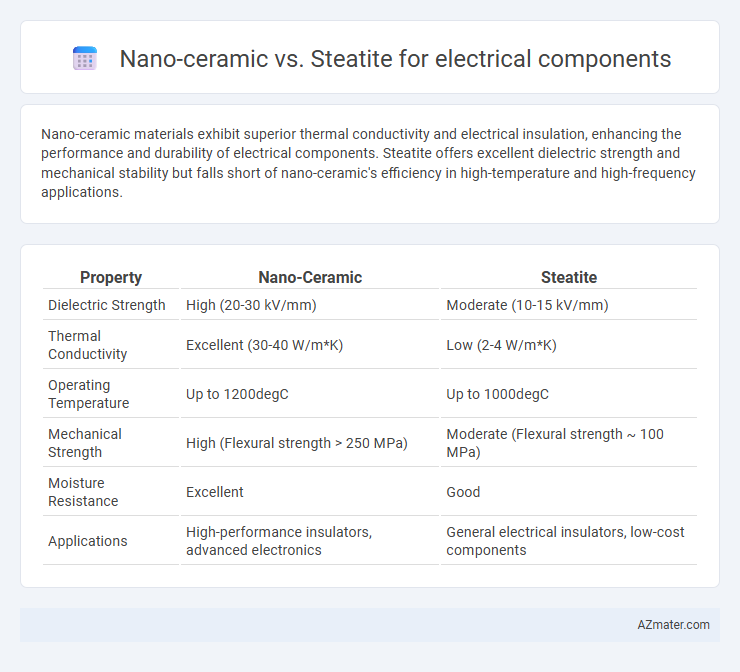Nano-ceramic materials exhibit superior thermal conductivity and electrical insulation, enhancing the performance and durability of electrical components. Steatite offers excellent dielectric strength and mechanical stability but falls short of nano-ceramic's efficiency in high-temperature and high-frequency applications.
Table of Comparison
| Property | Nano-Ceramic | Steatite |
|---|---|---|
| Dielectric Strength | High (20-30 kV/mm) | Moderate (10-15 kV/mm) |
| Thermal Conductivity | Excellent (30-40 W/m*K) | Low (2-4 W/m*K) |
| Operating Temperature | Up to 1200degC | Up to 1000degC |
| Mechanical Strength | High (Flexural strength > 250 MPa) | Moderate (Flexural strength ~ 100 MPa) |
| Moisture Resistance | Excellent | Good |
| Applications | High-performance insulators, advanced electronics | General electrical insulators, low-cost components |
Introduction to Nano-ceramic and Steatite in Electrical Components
Nano-ceramic materials exhibit exceptional electrical insulation, high thermal stability, and excellent mechanical strength, making them ideal for advanced electrical components such as capacitors, sensors, and insulators. Steatite, a magnesium silicate ceramic, is renowned for its high dielectric strength, low loss tangent, and resistance to thermal shock, commonly used in insulators and electronic substrates. Both materials serve critical functions in electrical engineering, with nano-ceramics offering enhanced performance at the nanoscale and steatite providing reliable, cost-effective insulation solutions.
Material Composition and Structure Comparison
Nano-ceramic materials consist of ceramic particles sized in the nanometer range, offering enhanced surface area and improved electrical insulation due to their uniform microstructure. Steatite, primarily composed of magnesium silicate, exhibits a crystalline structure with relatively larger grains, resulting in higher mechanical strength but lower thermal conductivity compared to nano-ceramics. The nano-ceramic's finer grain size provides superior dielectric properties and thermal stability, making it more suitable for high-frequency and miniaturized electrical components than steatite.
Electrical Insulation Properties
Nano-ceramic materials exhibit superior electrical insulation properties compared to steatite due to their high dielectric strength and minimal electrical conductivity, making them ideal for high-voltage applications. Steatite, primarily composed of magnesium silicate, offers good insulation but has lower dielectric strength and higher breakdown voltage thresholds. Nano-ceramics also provide enhanced thermal stability and resistance to electrical discharge, improving overall performance in demanding electrical environments.
Thermal Conductivity Performance
Nano-ceramic materials exhibit superior thermal conductivity compared to steatite, often reaching values above 30 W/m*K, which enhances heat dissipation in electrical components. Steatite, with thermal conductivity typically around 6-8 W/m*K, offers moderate heat transfer but excels in electrical insulation and mechanical strength. The higher thermal performance of nano-ceramics enables more efficient thermal management in high-power electronics, reducing overheating risks and improving device longevity.
Mechanical Strength and Durability
Nano-ceramic materials exhibit superior mechanical strength and durability compared to steatite in electrical components, owing to their fine-grained microstructure and enhanced fracture toughness. Steatite, while offering good thermal stability and electrical insulation, generally has lower mechanical strength, making it more susceptible to cracking under mechanical stress. The enhanced wear resistance and toughness of nano-ceramics lead to longer component lifespan in demanding electrical applications.
Resistance to Wear and Chemical Corrosion
Nano-ceramic materials exhibit superior resistance to wear and chemical corrosion compared to steatite, making them ideal for high-performance electrical components exposed to harsh environments. Nano-ceramic composites maintain structural integrity and electrical insulation under extreme conditions, while steatite, although resistant to thermal shock and electrical insulation, tends to degrade faster under aggressive chemical exposure and abrasive wear. The enhanced durability of nano-ceramics extends component lifespan and reliability in demanding industrial applications.
Manufacturing Processes and Scalability
Nano-ceramic materials offer precise control during manufacturing through advanced techniques like sol-gel processing and chemical vapor deposition, enabling consistent production of high-performance electrical components with superior dielectric properties. Steatite ceramics are typically manufactured using conventional powder pressing and sintering methods, which provide cost-effective scalability but may result in less uniform microstructures and dielectric performance. Scaling nano-ceramics involves more complex, often higher-cost processes suitable for high-tech applications, while steatite manufacturing is easier to scale for mass production due to established industrial methods.
Cost Efficiency and Market Availability
Nano-ceramic materials offer superior thermal stability and electrical insulation but come at a higher cost due to advanced manufacturing processes, limiting their use to high-performance applications. Steatite, known for its excellent dielectric properties and cost-effectiveness, remains widely available and preferred for mass-market electrical components. The choice between nano-ceramic and steatite hinges on balancing budget constraints with performance requirements in electrical component manufacturing.
Typical Applications in Electrical Engineering
Nano-ceramic materials offer high dielectric strength and thermal stability, making them ideal for advanced capacitors, insulators, and high-frequency electronic components. Steatite, known for excellent electrical insulation, mechanical strength, and thermal shock resistance, is commonly used in microwave components, electrical insulators, and circuit substrates. Both materials support efficient energy management and durability in demanding electrical engineering applications such as power distribution and high-voltage equipment.
Future Trends and Innovations in Ceramic Materials
Nano-ceramic materials demonstrate superior thermal stability and electrical insulation properties compared to traditional steatite ceramics, driving their adoption in high-performance electrical components. Innovations in nanoparticle doping and advanced sintering techniques are enhancing nano-ceramics' dielectric strength and mechanical resilience, positioning them as key materials in next-generation electronics and power systems. Future trends emphasize integrating nano-ceramic composites with smart sensors and IoT devices, enabling improved miniaturization and energy efficiency in electrical components.

Infographic: Nano-ceramic vs Steatite for Electrical component
 azmater.com
azmater.com